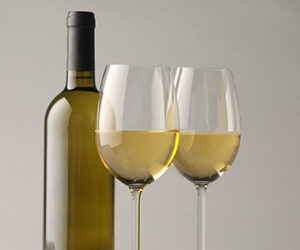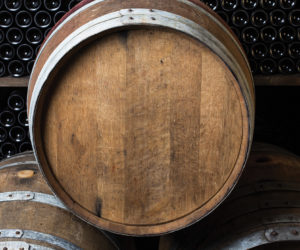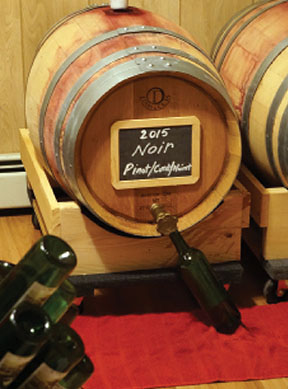 This point in the year is when my wines are bulk aged and filtered. It is a very important time in the evolution of my wine.
This point in the year is when my wines are bulk aged and filtered. It is a very important time in the evolution of my wine.
My basement, predominantly converted to my wine cellar, maintains a relatively consistent and cool temperature range, and this is where all the aging takes place. The temperature in the basement can vary from 55 to 65 °F (12 to 18 °C) over the course of the year. This range isn’t perfect, as long-term wine storage should have an even more limited temperature variation and be at the lower end of this range, but for a space that isn’t climatically controlled, it’s not bad.
Bulk aging is important for all wines thanks to multiple physical chemical reactions that take place long after all biological reactions are complete. These reactions go well beyond the scope of this article, but the bottom line is that wines need time and patience. Let nature do its thing.
So, what are those things that should be happening in the wine at this point? When it comes to white and rosé wines, clarification and stability are the major considerations. There is still an evolution of flavors and aromas in bulk aging at this stage, but clarification and stability are more important as they can create havoc once the wines have reached the bottle if you haven’t handled the wine properly during this stage. Even though a wine may look visually very clear to you it will continue to drop sediments for many months — and even longer. This is even the case after filtration, which I’ll discuss later. There is nothing more frustrating than believing your wine is completely stable and clear, bottling it, and then after a month checking those bottles to find various sediments have settled out in the bottle. Which brings us to the subject of stability. Stability is achieved over time and with proper SO2 management, and those reactions have to run their course, for the most part.
For red wines, everything that was said about white and rosés rings true. A big difference with red wines, however, involves the chemistry that surrounds tannins, which don’t really apply to any meaningful degree in most white wines. Tannin chemistry is also well beyond the scope of this article, but it is very important in the evolution of a red wine. Bulk aging for my red wines is a two-step process. The first step is bulk aging for six months in inert vessels — my FlexTanks and variable capacity stainless steel tanks. After six months I then rack my reds into oak barrels and begin the barrel aging process — always keeping tabs on my SO2 levels.
Oak Aging
I oak age all my dry red wines. I have found that the multiple facets of oak-based flavors and aromas greatly add to the complexity of my dry red wines, which I enjoy. Oak aging is not just about adding oak complexity to your wines, however. There is also a process called micro-oxidation, which occurs when aging your wine in an oak barrel. Micro-oxidation allows for a minute amount of air to enter the wines through the porous nature of the oak staves. This air, in the presence of the oak tannins, allows the wine to further evolve, then helps it to mellow and also unifies the components and attributes that make up that particular wine.
The time it takes to oak age wine in barrels varies based on the age and size of the barrel. For example, new, smaller barrels can quickly overwhelm a wine with oak as they contribute a greater amount of surface area based on the volume of wine. Also, the more vintages a barrel is used, the more time the wine will need to be aged; and after about four or five uses the barrel will essentially become inert. At that point, you will still get the benefits of micro-oxidation, but you will have to add oak adjuncts to the barrel to get the proper and sought after outcome.
I made wine for many years without using oak barrels. I had shied away from them due to their high cost and concerns with their maintenance. Instead, I stuck with the inert vessels and used oak adjuncts, like oak chips and spirals, to add a bit of complexity to my wines. Those wines were good. They did not, however, come close to the quality and complexity of wines that I’ve made using oak barrel aging. So oak barrels are here to stay in my home winery.
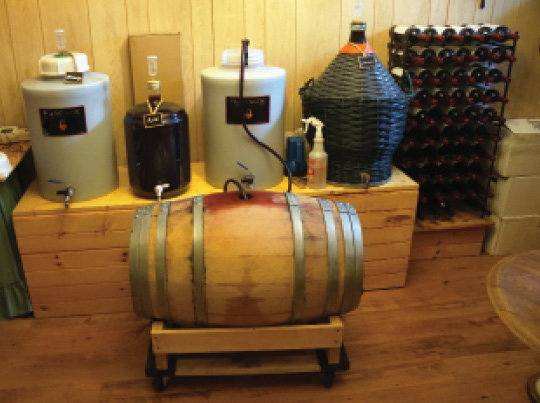
Filtration
After my white and rosé wines look totally clear to my eye, I run them through two stages of filtration. The first stage, polishing, creates a commercial quality brightness to the wine. The second stage, sterile, provides an extra level of assurance that my wine will remain stable in the bottle, even moreso than if I skipped that stage and just maintained proper SO2 levels. As I said earlier, however, bulk aging for an extended period prior to filtration goes a long way towards insuring stability.
I don’t typically filter my red wines. One reason is that because I use extended bulk aging, I’m not overly worried about sediments. Also, sediments in white and rosé wines are looked at and perceived as flaws. Sediments in reds, however, are looked at as character and quality as older red wines typically have sediments in the bottle.
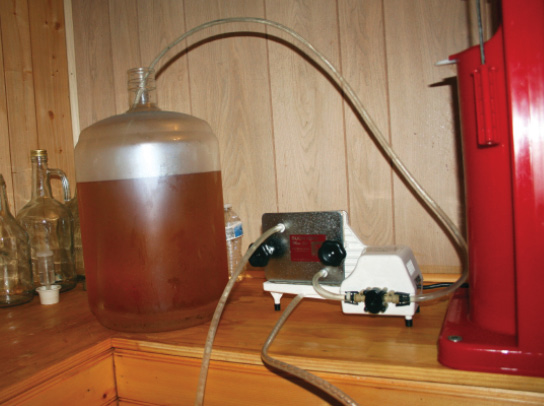
Bottling
Once I get to the point where I make the decision that a batch of wine is stable and ready, it is time to come out of bulk aging and start bottling.
In the past, I have filled all my cleaned bottles from spigots installed in my various bulk storage vessels. This isn’t a horrible approach for 6-gallon (23-L) carboys, but as I scaled up over the years it would have become quite a back-breaking undertaking for nearly 30-gallon (113-L) barrels. So this year I decided to upgrade my home bottling operation and add a three-bottle gravity filler. This required some additional equipment, beyond the filler, and some “home engineering” to create a working bottling station. Once the bottles are filled, they are corked with a floor corker. Once all the wine is bottled, I create some labels. To give all those bottles just a bit more of a professional feel, I also install shrink-style capsules on the neck of each bottle. Then each bottle is put on its side on the wine racks.
Bottle Aging
Finally, there is bottle aging. Much like bulk aging, bottle aging is needed to allow the wine to continue to evolve. When a wine is first bottled it can go through what is known as bottle shock. If a wine is experiencing bottle shock, it can taste completely different than what you bottled, and needs a few weeks or months to get back to normal. After that, bottle aging continues to occur. This is where the old adage that wine improves with age comes from. Some wines evolve better than others, however, and tannic red wines definitely need this time to mellow and improve. Fruity and acidic white wines, on the other hand, are better off enjoyed young.
So how do you exercise restraint and wait for your wine? A winemaker’s first instinct is to break right into those wines and enjoy them. If you drink them too quickly, however, you’ll never know what they may have grown into. In my household the solution is simple: We buy quality commercial wines as we wait. This is for a couple of reasons. First, it gives my homemade wines the time they need to evolve in the bottle. (We taste them along the way, which is very cool. The changes are amazing.) Second, trying a variety of commercial wines helps us to grow in our understanding of wines. When you drink quality wines from all over the world you gain a knowledge and appreciation of what winemakers are able to achieve. You also train and extend your palate. This way you can know what you like and what you don’t. You can then hone your skills as a winemaker to try to target those attributes in your homemade wines.
Well, I hope you have enjoyed my year-long look at the life of a homemade wine in my home winery. May you continue to enjoy this hobby and hopefully evolve in it along with your wines for many years.
Up Until harvest (sidebar)
When you have a home vineyard you have a number of pests that want to compete with you for all that wonderful fruit. In my area, the top contenders for homegrown grapes are deer, birds, and wasps. I have tried a number of different methods to try to keep all of them away from my grapes, including a number of scare and objectionable scent-based products are available on the market. In my experience, none of them work long-term. They may keep the targeted pest away for a period, but eventually they come back.
In the case of deer and birds, the only thing that truly works for me is exclusion. To that end, this year I installed a 7-foot (2-m) fence to encircle my nearly half-acre home vineyard. For the birds, I installed bird netting at the very beginning of veraison to keep them away from eating and pecking at the maturing grapes. For wasps, I have found that traps can be effective; this is highly dependent, however, on when they are installed. I grow some Concord grapes in my vineyard, which are highly aromatic as they ripen. The wasps can’t get enough of them. So about a week or two before the grapes start to become fragrant, I install the wasp traps with their attractants. The wasps are drawn to traps, greatly reducing their population near the vineyard. If I wait too long, however, they’ll take the grapes over the attractant in the trap any day.
From May through August I am also very diligent about my spray program for fungus control. I follow a ten to fourteen day spray schedule with a Mancozeb/Rally or Quintec mixture for May and June and a Captan/Monopotassium phosphate mixture for July and August. Luckily, I very rarely have to spray pesticides as the birds and larger bugs seem to keep the problematic pests at bay. I like to use Mancozeb in the beginning of the growing season as its zinc component helps with enhancing fruit set. You’ll notice I use a foliar-based fertilizer for the second half of the growing season — Monopotassium phosphate, which when applied as a 1% solution, actually provides for fungus based control, when used in combination with Captan. It has an added benefit of enhancing the plant’s root strength and growth and helping to develop sweeter fruit.
Also at this time of year I regularly walk through the vineyard and do some shoot thinning, hedging, and leaf pulls to ensure proper light and air exposure on the grape to provide for even and full ripening. I also just love walking through the vineyard — it gives me a sense of accomplishment and helps me to relax after a sometimes stressful day. Ever have one of those? This is best if done with a glass of a past vintage in hand!
Veraison is here before I know it and then I start planning and preparing for the big day – harvest. This is a period of regularly checking on the grapes’ sugars, pH, TA, and taste. The tasting is, by far, the biggest factor in determining when to pick for me. The other measurements are great indicators of progress, but nothing is more important than what your taste buds and gut are telling you about if a particular variety is ready to produce a quality wine.



